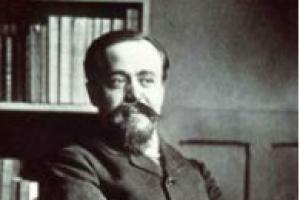For our ancient ancestors, the world was often limited to the land that surrounded and fed them. But even the earliest human civilizations still tried to measure the scale of this world and made the first attempts to draw maps.
The first such map is believed to have been created in Babylon over 2,500 years ago, and it shows the world outside the Babylonian kingdom in the form of poisonous waters and dangerous islands, where (as they believed) people could not survive.
Over time, maps gradually became larger in scale as people's knowledge of what lay beyond the Mediterranean grew. With the beginning of the era of wanderings and exploration in the 15th century, the concept of seeing the world changed, the East began to appear on maps, and a huge unexplored ocean appeared in place of America. And with the return of Columbus, maps of the world began to take on a form that was already understandable to us, modern people.
1. The oldest known map of the world is from Babylon (6th century BC). At the center of the world is the Kingdom of Babylon itself. There is a “bitter river” around him. The seven points across the river are islands that cannot be reached.

2. World map of Hecataeus of Miletus (5-6 century BC). Hecataeus divides the world into three parts: Europe, Asia and Libya, located around the Mediterranean Sea. His world is a round disk surrounded by ocean.

3. World map of Posidonius (2nd century BC). This map expands on the early Greek vision of the world, including the conquests of Alexander the Great.

4. World map of Pomponia Mela (43 AD)

5. Ptolemy's world map (150 AD). He was the first to add latitude and longitude lines to the world map.

6. Peitinger Tablet, a 4th-century Roman map showing the road network of the Roman Empire. The full map is very long, showing lands from Iberia to India. In the center of the world, of course, is Rome.

7. Map of the world by Kozma Indicoplov (6th century AD). The world is depicted as a flat rectangle.

8. A later Christian map in the form of a multi-colored clover leaf, compiled by Henry Banting (Germany, 1581). In fact, it does not describe the world, or rather, according to this map, the world is a continuation of the Christian Trinity, and Jerusalem is its center.

9. World map of Mahmud al-Kashgari (11th century). The world is centered around the ancient city of Balasagun, now the territory of Kyrgyzstan. Also included are places (countries) predicted to appear at the end of the world, such as Gog and Magog.

10. Map “Book of Roger” by Al-Idrisi, compiled in 1154. It was created based on information received from Arab traders who traveled around the world. At that time it was the most accurate and extensive map of the world. Europe and Asia are already clearly visible, but so far only the northern part of Africa is visible.

11. Hereford world map of the 14th century by one Richard of Haldingham. Jerusalem in the center, East at the top. The circle in the southern part of the map is the Garden of Eden.

12. Chinese map “Da Ming Hunyi Tu” from the late 14th century. The world through the eyes of the Chinese during the Ming Dynasty. China, of course, dominates, and all of Europe is squeezed into a small space in the west.

13. Genoese map, compiled in 1457 based on descriptions by Niccolò da Conti. This is how Europeans see the world and Asia after the opening of the first trade routes to Mongolia and China.

14. Projection of the globe Erdapfel (“Earth Apple”) by Martin Beheim (Germany, 1492). Erdapfel is the oldest known globe, showing the world as a sphere, but without America - instead there is still a huge ocean.

15. World map of Johann Ruysch, compiled in 1507. One of the first images of the New World.

16. Map by Martin Waldseemüller and Matthias Ringmann from 1507. This was the first map to refer to the New World as "America." America looks like a thin strip of the east coast.

17. World map of Gerard van Schagen 1689. By this time, most of the world has already been mapped, and only small parts of America remain empty.

18. Samuel Dunn's 1794 world map. By charting the discoveries of Captain James Cook, Dunn became the first cartographer to depict our world as accurately as possible.

Love gives rise to a thirst for knowledge. The desire to know everything about your beloved is an indispensable factor in the depth of feeling. The impulse of love makes every nuance, every detail, even the most microscopic, important. Together with knowledge, you seem to absorb the object of love itself - you make it a part of yourself, and at the same time dissolve in it. This is the mystery of the Great Unity.
All these descriptions also apply to love for the Motherland. When the glorious pages of history have been studied, when the feeling has been tested by the knowledge of inglorious episodes, you plunge into a new depth, where an endless labyrinth of details and nuances awaits you. Here a new horizon of feeling opens up - the horizon of the abyss.
Contemplating children's photographs of the object of love is the highest stage of feeling. Here, the love inside your heart no longer requires a foundation, proof of its presence. For great unity with the beloved, all that remains is to destroy temporary boundaries. In the mystery of contemplating children's photographs, the realization comes that you have always known your beloved - you remember her birth, you remember the color of her stroller, you remember her first word. Time is broken. The pillars of Hercules have been passed, and infinity opens before you...
Rodina does not have children's photographs. This role is played by ancient maps that captured her first steps in this world. Russian cartography appeared relatively late, so we can judge the first moments of Muscovite Rus' solely from the atlases of European cartographers. This makes contemplation acquire additional intrigue and depth.
Octava Europae Tabula, 1511
Let's start with one of the earliest published maps depicting Russia. Its author, the Venetian cartographer Bernard Silvanius, hardly visited Moscow lands before creating the tabula. For this reason, we probably will not find familiar toponyms on the map. However, those that exist are simply mesmerizing: the Riphean and Hyperborean mountains, Sarma, Roxolans, the Venedian Sea. There is not even a hint of Moscow, Novgorod, Kyiv, and this adds additional intrigue. From history we know that by this time the Italians had built the Moscow Kremlin, and the entire Italian guard was in the service of the then ruling Vasily III. Has the Venetian cartographer really not heard anything about the Grand Duchy of Moscow? Hardly! Cartographers in those days were quite informed in terms of geography. Apparently, Bernard Silvanius had his own reasons for hiding the fact of the existence of Muscovy.
Russiae, Moscoviae et Tartariae Descriptio, 1562

And here is a map issued by the publisher Ortelius in Antwerp. There are already many names close to the heart. And just as many mysteries.
In the upper left corner, between Korelia and Biarmia, we see the majestic figure of Ioannes Basilivs Magnus, in whom we recognize Ivan the Terrible. Here he is presented with the title of Emperor of Russia and Duke of Moscow.
This is probably the first evidence of the fact that a Russian monarch was named emperor. John IV most likely owes such honors to the English diplomat Anthony Jenkins, who was directly involved in the creation of the map.
It was Jenkins who convinced Grozny to give England the most favorable preferences in trade on the territory of Muscovy. And it was through Anthony Jenkins that John wooed the British Queen Elizabeth I. Probably, the British actually allowed a marriage alliance with the “Emperor of Russia,” since the map was actively spreading throughout Europe, demonstrating the “geographical” power of the potential chosen one of the unapproachable Virgin Queen.
Studying the map, we will certainly note the abundance of cities on the territory of Muscovy. The names of some of them are now difficult to identify. For example, the city of Kholopiya, located next to Uglich and Yaroslavl.
Map of Tsarevich Fyodor, son of Boris Godunov

This unique map was published in Amsterdam in 1613 by the Dutch cartographer Hessel Gerrits. The full name of this "tabula" is “Map of Russia according to the manuscript, which Fyodor, the son of Tsar Boris, took the trouble to draw.”
It is known that Fyodor Godunov was very interested in cartography and took lessons from Dutch cartographers, who were specially invited to Moscow. Gerrits, who had never been to Russia, most likely got Fyodor’s manuscript thanks to the merchant Isaac Massa, who lived in Muscovy for several years.
It's interesting that with light hand Isaac Massa also appeared this map, which was created by Dutch cartographers based on geographical notes made by a merchant during a trip to Russia.

Mercator's Two Russias

In a cartographic opus attributed to Gerardus Mercator, Russia is represented as an appendage of a certain Tartaria. Moscow is isolated from other civilization by forests. But life is in full swing in the northeast of the capital, where the concentration of cities reaches its maximum. We also observe relatively high urbanization near the Riphean Mountains and the White Sea region. It is curious that on an earlier map of the Flemish, published in 1595, Muscovy looked much more representative in terms of the number of settlements.

It is worth noting that the “Tartar tabula” was released only in 1619, 25 years after the death of the cartographer. Perhaps the editors made adjustments to the master’s work, taking into account that Russia experienced the Time of Troubles, and many cities were desolate.
A few more decades will pass, and Tartary as a toponym will disappear from the lexicon of European cartographers, along with Sarmatia, the Riphean, Hyperborean mountains and the mysterious area called Baida. Their place in Latin cartographic terminology will be replaced by a neologism - Imperium Russicum.
Maps are a product that countless people have worked on over six thousand years. Cartography appeared before writing, and the methods of drawing the earth and sea surfaces changed along with the entire human civilization: from the first rock paintings to digital online and offline maps containing ethnographic, economic, and social information about the inhabitants.
From the first day when maps began to be used for orientation in the world, shortcomings were identified in them: rivers changed their courses, fires destroyed forests, human settlements migrated from place to place, making it difficult to fix objects on the map. So the history of cards is also ancient history fixing bugs in an attempt to create the perfect product.
Today we will decide whether, centuries later, we have managed to get closer to the canonical scheme of reflecting the world.
The oldest maps of the world
In the picture above you see an exact copy of the original piece of mammoth tusk found in the vicinity of the city of Pavlov (Czech Republic). After many years of research, the design on the tusk was recognized as the oldest map known to date. Its age is estimated at 25–27 thousand years. The tusk depicts river bends, ridges, ravines of loose loess slopes, rocky peaks and a hunter's house.
Such a map, even for its creators, could not last long. It was necessary to change the design each time, make new map or find a fundamentally different way of orientation on the ground.
On the left is a bronze Heavenly disk from Nebra. On the right is Murdorff's gold disk (possibly a fake). Both discs contain maps of the locations of celestial bodies
How to capture an image of a terrain if the territory is undergoing constant transformation?
Perhaps it is worth navigating by unchanging objects - stars. The polar star, which is part of the constellation Ursa Minor, always points north, deviating only one and a half degrees during the night (due to precession, the role of the polar star in different time assigned to various stars). Knowing where the North Star is located, it is easy to determine the cardinal directions: when you look directly at the star, there will be east on the right side, west on the left, and south behind your back.
The first constellations were identified about 16 thousand years ago and appeared in various drawings of Paleolithic art. It should be borne in mind that the cartographic feature of the night sky drawings was used as by-effect. The celestial disk from Nebra (≈ 3000 BC), which depicts the Sun, Moon and 32 stars, was supposedly used to measure the angle between the points of sunrise and sunset during the solstices.
Selecting a Perspective
More than 6,000 years ago, the first top-down maps appeared. The fresco in the ancient settlement of Çatalhöyük is regarded as a detailed plan of the village. The streets in the village were not marked - probably, the isolation of each house was shown with light lines.
Modern reconstruction of the map at Çatalhöyük. Orange denotes a supposedly real volcano. White rectangles - houses covered with flat roofs
Copy of the "Carta Marina" map, made in 1949
The 1539 Carta Marina is remarkable because, perhaps for the first time, images of eerie sea creatures began to have practical utility - they correspond to currents, storm fronts, dangerous underwater rocks and shoals.
A map of Venice from 1565 is made in a style that is still used in tourist guides today.
Conformal Mercator projection, thanks to which it is possible to build nautical charts, in which the ship's course is depicted as a straight line
In 1569, cartographer Gerardus Mercator, in an effort to make the world "look right" on maps, developed a new projection using mathematical formulas. With the Mercator projection, maps take on the form we are familiar with.
“Map of the World placed in the head of a Fool”, 1590. The map depicts the world “dressed” in the traditional entourage of a court jester: a two-horned cap with bells and a jester’s staff
Map by Claes Janson Vischer "Leo Belgicus", 1611. Leo Belgicus is the Latin name for the Dutch lion. Since 1583, the Netherlands has often been depicted as a lion. The map shows the period of truce between Spain and the Seven United Provinces of the Netherlands.
In 1675, John Ogilby depicted roads on the map as narrow strips, excluding the rest of the surrounding area, leaving only the objects necessary for orientation. This old map became the prototype of maps in modern car navigators.
The fashion for axonometric projection in maps was established by the French in a detailed plan of Paris drawn up in 1734–1736. The Louvre Palace is visible in the image above. To appreciate the scale of the work, open the entire city plan. Almost three hundred years later, the Chinese did something similar for the Baidu search engine.
Have you heard of a “travel map”? On such a map, you need to paint over / erase a piece of the territory you visited, revealing the name and full geographical information. The first such map was created in 1761 by John Spilsbury, who invented the “cut map.” Each individual map piece contained a bit of geographic information. By collecting the necessary sites, it was possible to study the entire world known at that time.
By the 19th century, map creators began to try to visually display economic, social, and political information. However, until the mass adoption of digital maps in the 21st century, additional information on maps quickly became outdated.
Ultra-modern
In the 20th century, maps became incredibly detailed thanks first to aerial photography, then space photography. However, satellite images, while quickly gaining popularity, also quickly turned into just a tool for creating diagrams. On a city scale they are practically useless. Above forest areas - completely useless. Then projects came to the rescue, in which people began to independently mark on maps inaccessible objects for photography.
Nowadays, maps appear that reflect the interests of a variety of people. Thus, Greek researchers have developed a system that converts images of traditional paper maps into three-dimensional city plans. Using virtual reality gloves, a blind person can literally touch the map and read data from it (or turn on a voice engine that reads street names).
Airbnb is experimenting with creating maps whose boundaries are drawn according to cultural and contextual principles. On the map above, traditional “tourist” accommodations are highlighted in green, and accommodation from the Airbnb database is highlighted in red. Any template map recommends housing in the “green” zone, but more complete impressions of real life in the city you can learn from the “red” territory.
Once the blind spots finally disappeared, value-added cards quickly gained popularity. For example, on a map of New York you can see the most crime-ridden areas and areas where you can feel safe.
It is no coincidence that the second open source project in Mail.Ru Group (after the Tarantool database) was offline maps MAPS.ME, based on OpenStreetMap data. The essence of the OSM project (as well as MAPS.ME) is to give every person in the world free card, with which you can do anything. Over the thousands of years of card history, it was difficult to imagine such a thing, and pocket cards themselves appeared only in the 19th century. Now instead of pockets there is a smartphone, but at least the cards no longer need the Internet. Another difference between OSM and cartography of the past is accessibility. Anyone can independently make additions to the map almost as easily as making edits to a Wikipedia article. One of the most high-profile updates to MAPS.ME this year was the ability to edit maps by users themselves. Thanks to this, we will be able to find benches, fountains, best places in order to take a photo.
The advantages of open (in every sense) cards over commercial solutions are their versatility. The same terrain map with different sets of data is used in a huge number of situations. With the help of OSM, they mark forest paths and dirt roads, food distribution points in the poorest regions, forest fires... You name it!
Disadvantages of the era
Comparing maps of the past - not only from the Middle Ages, but also two thousand years ago - with modern ones, you involuntarily come to the conclusion that maps have evolved into a utilitarian information product. The design has become much simpler, and the cards themselves, oddly enough, are less detailed. Looking around the three-meter Renaissance canvas, you could see dozens, if not hundreds of additional objects along your route. The smartphone offers to reflect only what reflects the UX logic of the map creators: that is, the minimum available information per unit area.
The digital map does not need to impress with its design, because it seems to be just an add-on above the search bar - we are looking for ATMs, hotels, the shortest route, the nearest attraction. The map became not a guide to the world, but a time-saving tool. Extra information on it only wastes a person’s time resource. " People's cards“This issue is being resolved to the best of our ability by introducing filters - while there is still an opportunity to see the city with all the variety of its objects.
What does data minimization lead to? . This does not mean that some objects disappear from the map: you just need to reduce the scale. This method has both supporters (maps look clearer on a mobile device) and opponents (an unfamiliar area needs to be scaled and searched by squares if you don’t know the exact name of the object). The map, which at first glance is not overloaded with information, will only suggest the shortest route, and not the one where the most beautiful, safe, quiet path opens.
Modern maps are made not by artists/designers, not even cartographers, but by programmers. This is the requirement of the era, because if you don’t adapt the map to any mobile device, simply no one will use it. The map has ceased to be a work of art, has lost the terrible monsters that swallow ships, and at the same time has become surprisingly monotonous.
However, compared to ancient maps, modern ones have one significant advantage - they change very quickly. The day is not far off when the card will become fully personalized. For some, it will give details that require comprehension of all the details and nuances, for others - only a condensed, concentrated fact about the area.
One of interesting examples movement towards “personalization” - a map (with open source) of places of real walking distance Galton, built on the basis of OSM. The map is named after Francis Galton, an English explorer and geographer who in 1881 compiled the Isochronic passage chart, indicating the number of days to travel from Great Britain to various places.
A fragment of a map of "quiet" areas of New York, obtained based on an analysis of data on noise complaints.
What does such a card give? In addition to the obvious solution (where you can get to in a certain time, if you don’t know how to walk on water and pass through walls), you can calculate the rating of a place taking into account many parameters of objects located within walking distance.
Sooner or later, a single map of the world will cease to exist, because for different groups of people the world will be filled with different events. The metamorphoses will not affect basic concepts, such as generally accepted state boundaries or distances between cities, but the motorist, pedestrian, cyclist and bar-goer will be able to find exactly what interests them in the geography of the surrounding space.
And the map will again become a source of discoveries.
Heading:It is impossible to determine when they appeared. Among the archaeological finds on all continents one can see primitive drawings on stones, on bone plates, on birch bark, on wood - these are maps of the immediate surroundings. The maps of the ancient Egyptians and Assyrians have reached us. In the past and present centuries, travelers constantly turned to the cartographic art of the native population. Their maps provided an invaluable service to those who discovered and mapped unknown lands.
The French traveler Henri Duveyrier visited the central Sahara in 1859, in the areas where the Tuaregs lived. He failed to explore the Ahaggar highlands, and he put it on his map according to data reported to him by Sheikh Otkhan, who from wet sand sculpted the entire relief of the highlands. Other sources also speak about the same relief maps of the Tuaregs.
The southern neighbors of the Tuaregs, the Fulani, were also excellent in the art of cartography. The ruler of Sokoto, Sultan Belo, drew in the sand for the English major Hugh Clapperton the Quorra River along its entire course, with all the bends, turns, tributaries, and allowed his map to be redrawn on paper. French traveler Victor Largeau wrote in 1876 that a Fulban blacksmith drew for him a schematic map in the sand from Tripoli to Timbuktu (between these points the difference in latitude is as much as 16 degrees).
Professor K. Wale at the beginning of this century, crossing from the village of Lindi to Massasi, received from the black Dog Mbili a primitive map of his route. Lindi was depicted in the lower right corner, Massasi in the upper left. Individual huts and even the traveler’s house with its internal location were marked on the map. Edward Robert Flegel showed Chief Abdulrahman a map of part of Africa - the land of the Fulani people and neighboring tribes. The chief, together with one of his advisers, corrected this map by making a drawing in the sand.
When in 1840-1843 the English geographer C. T. Beak studied the sources of the Nile, he received from a resident of these places, the Muslim Omar ibn Neji, a simple, small map of the Sobat River basin, a tributary of the White Nile.
Russian scientist Alexander Fedorovich Middendorf (1815-1894) argued that most Siberian Tungus can quickly draw a map of their surroundings on the sand or snow.
Pyotr Alekseevich Kropotkin, a Russian revolutionary and geographer, in the 70s of the 19th century, traveling around Transbaikalia, was guided by a map that a Tungus carved for him on birch bark.
For the remarkable Russian geographer, ethnographer and anthropologist Dmitry Nikolaevich Anuchin, when he traveled through Siberia in 1906, a map of the area of the Yenisei River and its tributary, which is below the village of Lebedev, was drawn by a local resident Shigal.
He depicted the direction of the flow of the Yenisei using the silhouette of a duck flying in spring migration, and the south with a drawing of the sun as its symbol. At first Shigal drew the sun not exactly in the south, but then corrected his mistake. He marked the forest with two firs. Anuchin recognized the card as very good.
The evidence of V. Jochelson, who at the end of the 9th century conducted a geographical and ethnographic study of the Kolyma region, has been preserved. He received from local residents two small maps made on birch bark. The maps depicted the Kolyma with its tributaries Korkodon and Rassokha, and next to them were villages and hunting grounds.
When L. Strenberg traveled around Sakhalin, his guide was a Nivkh, who made for him a map of the southern part of Sakhalin. He drew the path of the ship "Baikal" from the village of Korsakovskaya to Aleksandrovsk and those protrusions of the mainland past which they sailed.
The Australian aborigines especially amazed travelers with their maps. There were tribes there who lived, perhaps, at the lowest level of social development, almost at the level of the Stone Age, and many of these people were able to draw a surprisingly accurate plan of the surrounding area on a stone or on a piece of tree bark.
In South Australia, designs made on batons are known. These drawings have the meaning of proprietary and tribal symbols, but, in fact, depict the area in which the tribe lives. Thus, for example, in the drawing given here, the native depicted a branch of the Brocken River and a swamp in New South Wells. This is a map of the territory that his tribe occupies, between the swamp and the river.
Completely different and highly original maps were created by the inhabitants of the Marshall Islands and Polynesia - stick maps. The natives used them when sailing between the islands of the archipelago. The first news about these maps was brought to Europe by the German consul F. Gernsheim. There are currently about 50 such maps in European collections. They are made from thin sticks located in different directions to each other - straight, at an angle, and shells or pebbles are attached to them. All this is connected by threads of palm fibers. The sticks show the direction of sea currents and the most convenient routes for navigation. Pebbles or shells represent islands.
Augustine Kramer, traveling through the South Pacific in 1897-1899, saw one of the native leaders with a map of the Marshall Islands drawn in a notebook - in shape and outline it resembled stick maps.
One of the first news about Polynesian maps was brought by James Cook (1728-1779). His guide on the 1776 voyage was the Polynesian chief Tupaia. Naturally intelligent, Tupaia knew Polynesia well. Based on his information, a map of the area was drawn up, located between 130°-170° west longitude and 7°-27° south latitude. The map covered an area of 9,200 km2 and included 80 islands. The map has not survived to this day, but two copies exist.
Very interesting information travelers left about the cartographic abilities of the Eskimos - both from the north of Canada and Alaska, and from Greenland. The English Arctic explorer William Edward Parry explored the Hudson Bay area in 1821-1823. The Eskimo Iliglyuk made a sketch for him, with the help of which in July 1822 Parry discovered the strait between the Melville Peninsula and Baffin Island. The Eskimos helped Frederick William Beachy on his journey through the Bering Strait to Kotzebue Bay: they drew him a map on the ground, marking mountains and islands with stones, and fishing villages with sticks stuck into the ground.
In 1848-1859, English captain Francis Leopold McClintock took part in the expedition to rescue polar explorer John Franklin. The Eskimos provided McClintock with valuable information: they drew maps of the coast of Elio Bay and other places on the coast, and even indicated the position of the skeletons of both of Franklin's lost ships. McClintock especially appreciated the maps drawn for him by the Eskimos A-Vah-Lah and Ov-Vang-Noot.
Beginning in 1883, research in the Hudson Bay area was carried out by F. Boa. Many Eskimos and Eskimos made various sketch maps for him. The most interesting of them is the one depicting the Bechler Islands in Hudson Bay. The islands are drawn with amazing accuracy, the image almost completely coincides with the then map of the British navy.
Many travelers noted that the Eskimos, who picked up a pencil for the first time in their lives, could very accurately and in detail depict the outlines of their coast. The extraordinary orientation abilities of the Eskimos were also described by the American geographer Boizet. In 1898, the Eskimo Nuktan, a resident of North Greenland, drew him a map of Smith Bay, identifying areas with and without perpetual glaciers. Later data showed that this is a very accurate drawing.
Danish ethnologist Kai Birketsmit talks about a very special kind of maps. These are relief maps that were carved from wood by the East Greenlandic Eskimos. One of these maps is kept in the National Museum of Copenhagen. The map consists of two parts that are not connected to each other: the left part shows the eastern coast of Greenland, and the narrower right part shows a chain of islands located in front of the coast.
Canadian polar explorer Vilhjalmur Stefanson noted this interesting feature in Eskimo maps: they depict everything that they consider important to them, for example, piers for boats. And the mountains stretching along the coast are unimportant to them; they don’t even depict them.
| ← From the history of the discovery and development of the Commander Islands |
|---|








